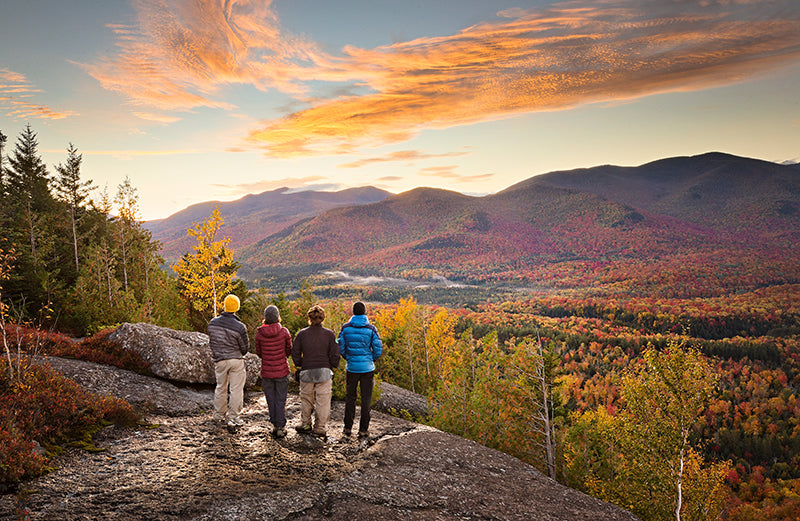Hiking offers a unique way to connect with nature, providing both physical exercise and mental clarity. However, like any physical activity, hiking can lead to injuries if not approached with care. Strains and sprains are common among hikers, especially when the terrain is rugged, or the trail is long. The key to avoiding these injuries lies in proper preparation—specifically, incorporating pre-hike stretches and precautions into your routine, as you'll soon find out here today.
What Defines Being a Hiking Enthusiast?
Being a hiking enthusiast goes beyond enjoying a walk in the woods or even investing in certain gear. It’s about a deep appreciation for the outdoors and a commitment to exploring new trails, overcoming physical challenges, and embracing nature in all its forms. Hiking enthusiasts are characterized by their passion for adventure, consistent trail exploration, and respect for environmental preservation.
For hiking enthusiasts, the journey is just as rewarding as the destination. However, this dedication requires physical preparedness, especially when tackling more challenging trails. Being a hiking enthusiast often means pushing your body to its limits, which makes injury prevention even more crucial.
The Overall Importance of Stretching Before You Hike
Stretching before any physical activity, particularly hiking, is essential for preventing injuries like strains, sprains, and muscle fatigue. Hiking often involves uneven terrain, varying elevations, and unpredictable weather conditions that can put significant strain on your muscles and joints. Without adequate preparation, these physical demands increase the risk of injury. In fact, stretching helps in terms of:
-
Injury Prevention: Stretching improves flexibility and joint range of motion, reducing the chances of sprains, strains, and muscle tears.
-
Improved Performance: A properly stretched body performs better. You will have better endurance, balance, and strength during your hike.
-
Circulation Boost: Stretching helps increase blood flow to your muscles, ensuring they receive the oxygen and nutrients they need during strenuous activity.
-
Increased Flexibility: When your muscles are limber, they’re less likely to cramp up or pull under strain, making your hike more enjoyable.
Basically, this not only enhances performance but also reduces the likelihood of muscle stiffness and injury while on the trail. Pre-hike stretches target key areas like the hips, calves, hamstrings, and lower back, which bear the brunt of hiking activities.
Keep in mind, too, that stretching isn't just something you do for a few seconds before setting off; it should be an integral part of your hiking routine. Warming up your body and loosening tight muscles can prevent small aches from becoming major injuries.
Why Do You Need to Have Precautions in Place to Avoid Strains and Sprains?
Precautions are vital because hiking is a full-body workout that tests your endurance, balance, and strength. Again, strains and sprains are common in hiking due to uneven surfaces, slippery rocks, and sudden movements. Even experienced hikers can misstep or overexert themselves, leading to painful injuries that could have been prevented with proper planning and precautionary measures. A few of the numerous common hiking injuries are:
-
Sprains: Occur when the ligaments around a joint are stretched or torn, commonly in the ankles.
-
Strains: Muscle or tendon injuries due to overstretching or excessive use, often in the legs or lower back.
-
Blisters: Though not severe, blisters can hinder your hike and lead to more serious issues like infections if not treated.
The right precautions not only protect your body but also enhance your hiking experience. Being mindful of your limits, staying hydrated, wearing appropriate gear, and stretching are all integral steps that can make the difference between a memorable hike, and one cut short by injury. For added support during your hike, you can apply a topical CBD balm to help warm up your muscles before hitting the trail.
What are Some Actual Pre-Hike Stretches and Precautions You Can Do to Avoid Strains and Sprains?
There are various stretches and precautions you can implement to safeguard yourself before hitting the trail. From targeting specific muscle groups to following proper safety guidelines, these methods will help reduce the risk of strains and sprains.
Pre-Hike Stretches and Precautions #1: Calf Stretch
The calf muscles are heavily engaged when hiking, especially during uphill climbs. A proper calf stretch will help you avoid muscle tightness and cramps. Stand facing a wall, place your hands against it, and step one leg back, pressing your heel into the ground. Hold for 20-30 seconds and switch legs.
Precaution: Make sure to wear supportive, well-fitting hiking boots to protect your feet and lower legs from excessive strain.
Pre-Hike Stretches and Precautions #2: Hip Flexor Stretch
Your hips provide stability and mobility while hiking, especially when navigating uneven terrain. Stretching your hip flexors reduces the risk of lower back and hip pain. Kneel on one knee, keeping the other foot in front with the knee bent. Push your hips forward gently, feeling a stretch along the front of your hip. Hold for 30 seconds on each side.
Precaution: Consider using a hiking pole to reduce strain on your hips, particularly during steep ascents or descents.
Pre-Hike Stretches and Precautions #3: Hamstring Stretch
Tight hamstrings can lead to lower back pain and limit your range of motion on the trail. To stretch them, sit on the ground with one leg extended and the other bent, foot placed against the inner thigh of the extended leg. Lean forward toward the extended leg, keeping your back straight, and hold the position for 20-30 seconds.
Precaution: Don’t overload your backpack; the extra weight can put strain on your back and hamstrings.
Pre-Hike Stretches and Precautions #4: Quadriceps Stretch
Your quads take on a lot of the work when climbing, so keeping them loose is crucial. Stand on one leg, grab your other ankle behind you, and pull it toward your glutes. Keep your knees close together and hold for 30 seconds before switching legs.
Precaution: Stay hydrated throughout your hike to avoid muscle cramps and fatigue.
Pre-Hike Stretches and Precautions #5: Shoulder and Neck Stretch
Hiking involves more than just your legs. Your shoulders and neck also bear some strain, particularly if you're carrying a backpack. Stretch these areas by gently tilting your head to one side and holding for about 15-20 seconds, then switch sides. For your shoulders, clasp your hands behind your back and gently lift them upward for a good stretch.
Precaution: Always adjust your backpack to distribute weight evenly, preventing undue stress on your neck and shoulders.
Pre-Hike Stretches and Precautions #6: Lower Back Stretch
Hiking often results in tension in the lower back due to long periods of walking and uneven ground. Perform a simple lower back stretch by lying on your back and bringing your knees to your chest, gently rocking side to side. This stretch helps loosen up your lower back muscles and relieves tension.
Precaution: Take breaks during your hike, especially on long trails, to rest your back and avoid overexertion.
Pre-Hike Stretches and Precautions #7: Ankle Circles
Ankles are vulnerable during hikes due to uneven terrain. Strengthen and stretch your ankles by doing ankle circles. Sit or stand and rotate your ankles in circular motions in both directions. Repeat for 10-15 seconds on each side.
Precaution: Be cautious on rocky or slippery surfaces where ankle injuries are more likely to occur. Hiking boots with good ankle support are essential.
Pre-Hike Stretches and Precautions #8: Hip Circles
Loosening up your hips is important, especially when navigating steep or uneven trails. Perform hip circles by standing with your feet hip-width apart and rotating your hips in large, controlled circles. Repeat 10 times in each direction.
Precaution: Always assess trail difficulty beforehand and be mindful of your physical limits. Pushing beyond your capabilities increases the risk of injury.
Pre-Hike Stretches and Precautions #9: Side Lunges
Side lunges help strengthen and stretch your inner thighs, which support lateral movements on uneven ground. Stand with your feet wide apart, then lunge to one side, bending one knee while keeping the other leg straight. Hold for 20 seconds, then switch sides.
Precaution: Wear proper hiking footwear that provides stability and grip, reducing the likelihood of slipping or mis-stepping.
Pre-Hike Stretches and Precautions #10: Dynamic Walking Lunges
Dynamic lunges mimic the motions you’ll use during your hike, helping to activate the muscles you’ll rely on most. Step forward into a lunge, keeping your back straight, then push off with your back leg to step forward with the other. Continue for 10 steps on each leg.
Precaution: Start your hike at a steady pace. Jumping into a fast or strenuous pace too quickly can lead to muscle strain.
Pre-Hike Stretches and Precautions #11: Arm Swings
Arm swings help loosen your shoulders and improve upper body mobility, which is useful when carrying gear. Stand tall and swing your arms forward and back, alternating between each arm. Do this for 30 seconds.
Precaution: Keep your arms relaxed when using trekking poles to avoid unnecessary strain on your shoulders and elbows.
Pre-Hike Stretches and Precautions #12: Balance Training
Good balance is critical for hiking, especially on rugged or slippery trails. A simple balance exercise is to stand on one foot for 30 seconds, then switch feet. For added difficulty, try closing your eyes while maintaining your balance.
Precaution: Always stay alert to your surroundings. Uneven or loose terrain can cause you to lose balance and fall if you’re not careful.
Make Your Next Hike an Injury-Free One!
Preventing injuries on the trail is about being proactive with your body. By incorporating these stretches and precautions into your pre-hike routine, you will set yourself up for a safe and enjoyable experience in nature. Whether you're exploring new trails or returning to a favorite spot, taking care of your body before you hike will ensure that your adventures remain injury-free. Remember, hiking is about the journey as much as the destination—so take the time to prepare and enjoy every step!










































